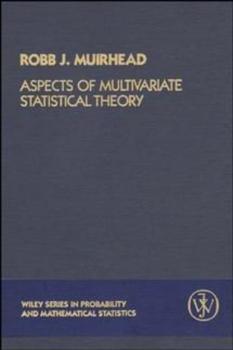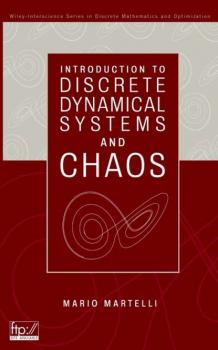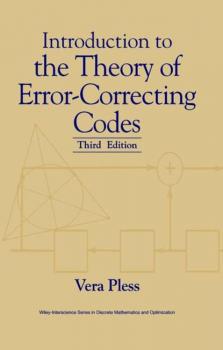Группа авторов
Список книг автора Группа авторовAspects of Multivariate Statistical Theory
The Wiley-Interscience Paperback Series consists of selected books that have been made more accessible to consumers in an effort to increase global appeal and general circulation. With these new unabridged softcover volumes, Wiley hopes to extend the lives of these works by making them available to future generations of statisticians, mathematicians, and scientists. «. . . the wealth of material on statistics concerning the multivariate normal distribution is quite exceptional. As such it is a very useful source of information for the general statistician and a must for anyone wanting to penetrate deeper into the multivariate field.» -Mededelingen van het Wiskundig Genootschap «This book is a comprehensive and clearly written text on multivariate analysis from a theoretical point of view.» -The Statistician Aspects of Multivariate Statistical Theory presents a classical mathematical treatment of the techniques, distributions, and inferences based on multivariate normal distribution. Noncentral distribution theory, decision theoretic estimation of the parameters of a multivariate normal distribution, and the uses of spherical and elliptical distributions in multivariate analysis are introduced. Advances in multivariate analysis are discussed, including decision theory and robustness. The book also includes tables of percentage points of many of the standard likelihood statistics used in multivariate statistical procedures. This definitive resource provides in-depth discussion of the multivariate field and serves admirably as both a textbook and reference.
Solutions Manual to accompany Modern Engineering Statistics
An introductory perspective on statistical applications in the field of engineering Modern Engineering Statistics presents state-of-the-art statistical methodology germane to engineering applications. With a nice blend of methodology and applications, this book provides and carefully explains the concepts necessary for students to fully grasp and appreciate contemporary statistical techniques in the context of engineering. With almost thirty years of teaching experience, many of which were spent teaching engineering statistics courses, the author has successfully developed a book that displays modern statistical techniques and provides effective tools for student use. This book features: Examples demonstrating the use of statistical thinking and methodology for practicing engineers A large number of chapter exercises that provide the opportunity for readers to solve engineering-related problems, often using real data sets Clear illustrations of the relationship between hypothesis tests and confidence intervals Extensive use of Minitab and JMP to illustrate statistical analyses The book is written in an engaging style that interconnects and builds on discussions, examples, and methods as readers progress from chapter to chapter. The assumptions on which the methodology is based are stated and tested in applications. Each chapter concludes with a summary highlighting the key points that are needed in order to advance in the text, as well as a list of references for further reading. Certain chapters that contain more than a few methods also provide end-of-chapter guidelines on the proper selection and use of those methods. Bridging the gap between statistics education and real-world applications, Modern Engineering Statistics is ideal for either a one- or two-semester course in engineering statistics.
A Statistical Approach to Neural Networks for Pattern Recognition
An accessible and up-to-date treatment featuring the connection between neural networks and statistics A Statistical Approach to Neural Networks for Pattern Recognition presents a statistical treatment of the Multilayer Perceptron (MLP), which is the most widely used of the neural network models. This book aims to answer questions that arise when statisticians are first confronted with this type of model, such as: How robust is the model to outliers? Could the model be made more robust? Which points will have a high leverage? What are good starting values for the fitting algorithm? Thorough answers to these questions and many more are included, as well as worked examples and selected problems for the reader. Discussions on the use of MLP models with spatial and spectral data are also included. Further treatment of highly important principal aspects of the MLP are provided, such as the robustness of the model in the event of outlying or atypical data; the influence and sensitivity curves of the MLP; why the MLP is a fairly robust model; and modifications to make the MLP more robust. The author also provides clarification of several misconceptions that are prevalent in existing neural network literature. Throughout the book, the MLP model is extended in several directions to show that a statistical modeling approach can make valuable contributions, and further exploration for fitting MLP models is made possible via the R and S-PLUS® codes that are available on the book's related Web site. A Statistical Approach to Neural Networks for Pattern Recognition successfully connects logistic regression and linear discriminant analysis, thus making it a critical reference and self-study guide for students and professionals alike in the fields of mathematics, statistics, computer science, and electrical engineering.
Maximum Likelihood Estimation and Inference
This book takes a fresh look at the popular and well-established method of maximum likelihood for statistical estimation and inference. It begins with an intuitive introduction to the concepts and background of likelihood, and moves through to the latest developments in maximum likelihood methodology, including general latent variable models and new material for the practical implementation of integrated likelihood using the free ADMB software. Fundamental issues of statistical inference are also examined, with a presentation of some of the philosophical debates underlying the choice of statistical paradigm. Key features: Provides an accessible introduction to pragmatic maximum likelihood modelling. Covers more advanced topics, including general forms of latent variable models (including non-linear and non-normal mixed-effects and state-space models) and the use of maximum likelihood variants, such as estimating equations, conditional likelihood, restricted likelihood and integrated likelihood. Adopts a practical approach, with a focus on providing the relevant tools required by researchers and practitioners who collect and analyze real data. Presents numerous examples and case studies across a wide range of applications including medicine, biology and ecology. Features applications from a range of disciplines, with implementation in R, SAS and/or ADMB. Provides all program code and software extensions on a supporting website. Confines supporting theory to the final chapters to maintain a readable and pragmatic focus of the preceding chapters. This book is not just an accessible and practical text about maximum likelihood, it is a comprehensive guide to modern maximum likelihood estimation and inference. It will be of interest to readers of all levels, from novice to expert. It will be of great benefit to researchers, and to students of statistics from senior undergraduate to graduate level. For use as a course text, exercises are provided at the end of each chapter.
Statistical Estimation of Epidemiological Risk
Statistical Estimation of Epidemiological Risk provides coverage of the most important epidemiological indices, and includes recent developments in the field. A useful reference source for biostatisticians and epidemiologists working in disease prevention, as the chapters are self-contained and feature numerous real examples. It has been written at a level suitable for public health professionals with a limited knowledge of statistics. Other key features include: Provides comprehensive coverage of the key epidemiological indices. Includes coverage of various sampling methods, and pointers to where each should be used. Includes up-to-date references and recent developments in the field. Features many real examples, emphasising the practical nature of the book. Each chapter is self-contained, allowing the book to be used as a useful reference source. Includes exercises, enabling use as a course text.
Numerical Methods in Finance and Economics
A state-of-the-art introduction to the powerful mathematical and statistical tools used in the field of finance The use of mathematical models and numerical techniques is a practice employed by a growing number of applied mathematicians working on applications in finance. Reflecting this development, Numerical Methods in Finance and Economics: A MATLAB?-Based Introduction, Second Edition bridges the gap between financial theory and computational practice while showing readers how to utilize MATLAB?–the powerful numerical computing environment–for financial applications. The author provides an essential foundation in finance and numerical analysis in addition to background material for students from both engineering and economics perspectives. A wide range of topics is covered, including standard numerical analysis methods, Monte Carlo methods to simulate systems affected by significant uncertainty, and optimization methods to find an optimal set of decisions. Among this book's most outstanding features is the integration of MATLAB?, which helps students and practitioners solve relevant problems in finance, such as portfolio management and derivatives pricing. This tutorial is useful in connecting theory with practice in the application of classical numerical methods and advanced methods, while illustrating underlying algorithmic concepts in concrete terms. Newly featured in the Second Edition: * In-depth treatment of Monte Carlo methods with due attention paid to variance reduction strategies * New appendix on AMPL in order to better illustrate the optimization models in Chapters 11 and 12 * New chapter on binomial and trinomial lattices * Additional treatment of partial differential equations with two space dimensions * Expanded treatment within the chapter on financial theory to provide a more thorough background for engineers not familiar with finance * New coverage of advanced optimization methods and applications later in the text Numerical Methods in Finance and Economics: A MATLAB?-Based Introduction, Second Edition presents basic treatments and more specialized literature, and it also uses algebraic languages, such as AMPL, to connect the pencil-and-paper statement of an optimization model with its solution by a software library. Offering computational practice in both financial engineering and economics fields, this book equips practitioners with the necessary techniques to measure and manage risk.
Partial Differential Equations and the Finite Element Method
A systematic introduction to partial differential equations and modern finite element methods for their efficient numerical solution Partial Differential Equations and the Finite Element Method provides a much-needed, clear, and systematic introduction to modern theory of partial differential equations (PDEs) and finite element methods (FEM). Both nodal and hierachic concepts of the FEM are examined. Reflecting the growing complexity and multiscale nature of current engineering and scientific problems, the author emphasizes higher-order finite element methods such as the spectral or hp-FEM. A solid introduction to the theory of PDEs and FEM contained in Chapters 1-4 serves as the core and foundation of the publication. Chapter 5 is devoted to modern higher-order methods for the numerical solution of ordinary differential equations (ODEs) that arise in the semidiscretization of time-dependent PDEs by the Method of Lines (MOL). Chapter 6 discusses fourth-order PDEs rooted in the bending of elastic beams and plates and approximates their solution by means of higher-order Hermite and Argyris elements. Finally, Chapter 7 introduces the reader to various PDEs governing computational electromagnetics and describes their finite element approximation, including modern higher-order edge elements for Maxwell's equations. The understanding of many theoretical and practical aspects of both PDEs and FEM requires a solid knowledge of linear algebra and elementary functional analysis, such as functions and linear operators in the Lebesgue, Hilbert, and Sobolev spaces. These topics are discussed with the help of many illustrative examples in Appendix A, which is provided as a service for those readers who need to gain the necessary background or require a refresher tutorial. Appendix B presents several finite element computations rooted in practical engineering problems and demonstrates the benefits of using higher-order FEM. Numerous finite element algorithms are written out in detail alongside implementation discussions. Exercises, including many that involve programming the FEM, are designed to assist the reader in solving typical problems in engineering and science. Specifically designed as a coursebook, this student-tested publication is geared to upper-level undergraduates and graduate students in all disciplines of computational engineeringand science. It is also a practical problem-solving reference for researchers, engineers, and physicists.
Logic-Based Methods for Optimization
A pioneering look at the fundamental role of logic in optimization and constraint satisfaction While recent efforts to combine optimization and constraint satisfaction have received considerable attention, little has been said about using logic in optimization as the key to unifying the two fields. Logic-Based Methods for Optimization develops for the first time a comprehensive conceptual framework for integrating optimization and constraint satisfaction, then goes a step further and shows how extending logical inference to optimization allows for more powerful as well as flexible modeling and solution techniques. Designed to be easily accessible to industry professionals and academics in both operations research and artificial intelligence, the book provides a wealth of examples as well as elegant techniques and modeling frameworks ready for implementation. Timely, original, and thought-provoking, Logic-Based Methods for Optimization: * Demonstrates the advantages of combining the techniques in problem solving * Offers tutorials in constraint satisfaction/constraint programming and logical inference * Clearly explains such concepts as relaxation, cutting planes, nonserial dynamic programming, and Bender's decomposition * Reviews the necessary technologies for software developers seeking to combine the two techniques * Features extensive references to important computational studies * And much more
Introduction to Discrete Dynamical Systems and Chaos
A timely, accessible introduction to the mathematics of chaos. The past three decades have seen dramatic developments in the theory of dynamical systems, particularly regarding the exploration of chaotic behavior. Complex patterns of even simple processes arising in biology, chemistry, physics, engineering, economics, and a host of other disciplines have been investigated, explained, and utilized. Introduction to Discrete Dynamical Systems and Chaos makes these exciting and important ideas accessible to students and scientists by assuming, as a background, only the standard undergraduate training in calculus and linear algebra. Chaos is introduced at the outset and is then incorporated as an integral part of the theory of discrete dynamical systems in one or more dimensions. Both phase space and parameter space analysis are developed with ample exercises, more than 100 figures, and important practical examples such as the dynamics of atmospheric changes and neural networks. An appendix provides readers with clear guidelines on how to use Mathematica to explore discrete dynamical systems numerically. Selected programs can also be downloaded from a Wiley ftp site (address in preface). Another appendix lists possible projects that can be assigned for classroom investigation. Based on the author's 1993 book, but boasting at least 60% new, revised, and updated material, the present Introduction to Discrete Dynamical Systems and Chaos is a unique and extremely useful resource for all scientists interested in this active and intensely studied field. An Instructor's Manual presenting detailed solutions to all the problems in the book is available upon request from the Wiley editorial department.
Introduction to the Theory of Error-Correcting Codes
A complete introduction to the many mathematical tools used to solve practical problems in coding. Mathematicians have been fascinated with the theory of error-correcting codes since the publication of Shannon's classic papers fifty years ago. With the proliferation of communications systems, computers, and digital audio devices that employ error-correcting codes, the theory has taken on practical importance in the solution of coding problems. This solution process requires the use of a wide variety of mathematical tools and an understanding of how to find mathematical techniques to solve applied problems. Introduction to the Theory of Error-Correcting Codes, Third Edition demonstrates this process and prepares students to cope with coding problems. Like its predecessor, which was awarded a three-star rating by the Mathematical Association of America, this updated and expanded edition gives readers a firm grasp of the timeless fundamentals of coding as well as the latest theoretical advances. This new edition features: * A greater emphasis on nonlinear binary codes * An exciting new discussion on the relationship between codes and combinatorial games * Updated and expanded sections on the Vashamov-Gilbert bound, van Lint-Wilson bound, BCH codes, and Reed-Muller codes * Expanded and updated problem sets. Introduction to the Theory of Error-Correcting Codes, Third Edition is the ideal textbook for senior-undergraduate and first-year graduate courses on error-correcting codes in mathematics, computer science, and electrical engineering.









